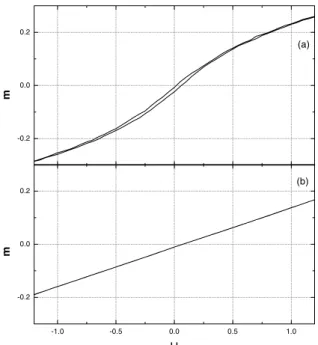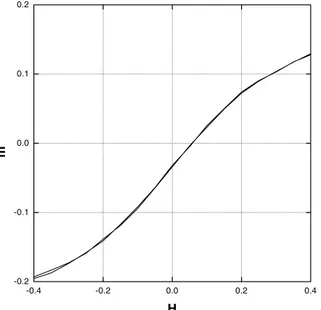Brazilian Journal of Physics, vol. 34, no. 2A, June, 2004 403
Critical Behavior of the Fully Frustrated
Two Dimensional
XY
model
A.B. Lima and B.V. Costa
Departamento de F´ısica ICEX, Universidade Federal de Minas Gerais
Caixa Postal 702, 30123-970 Belo Horizonte, MG, Brazil
Received on 8 August, 2004
Using Monte Carlo simulations we have investigated the critical behavior of the classical fully frustratedXY
model in two dimensions in a square lattice. There are two phase transitions in the model, one of the Berezinskii-Kosterlitz-Thouless type and aZ2transition at higher temperature. We show that the vortex anti-vortex density
has a clear signature of theZ2phase transition at exactly the percolation threshold.
1
Introduction
Classical continuous spin models with short range interac-tions in two dimensions are a prototype for systems which exhibit topological excitations [1]. It is well known that this kind of model undergoes a phase transition at a finite tem-perature TBKT, from a high-temperature phase where the
spin-spin correlations decay exponentially to a low temper-ature phase where they have a power-law decay. This phase transition is believed to be driven by a vortex-antivortex un-binding mechanism [2]. A vortex (antivortex) is a topolog-ical excitation in which spins on a closed path around the excitation have a positive (negative) chirality,f
f =
plaquete
(θi−θj), (1)
where θ is the angle that the XY spin vector component makes with some fixed direction in the plane. The mod-els we are interested in can be described by the following Hamiltonian
H =
<i,j>
Ji,j(SixS x j +S
y iS
y
j), (2)
whereSi = {Six, S y
i, Six}is a spin vector at sitei,Ji,j is
an exchange coupling which is ferromagnetic in all lines in the x direction and is alternately ferromagnetic and anti-ferromagnetic in the y direction. The coupling distribu-tion leads the ground state of the model to have a checker-board pattern of plaquetes with positive (vortex) or nega-tive (anti-vortex) chirality f /π = ±1. Due to this sym-metry the model has a Z2 transition at TZ2 [3]. In a
re-cent work we have shown that TBKT = 0.3655(5)J and
TZ2 = 0.3690(3)J for theXY model [4]. The vortex
den-sity atT = 0isρ = 1. Once the temperature grows, pairs vortex anti-vortex begin to annihilate so that we have a di-luted Ising model to deal with. Using Monte Carlo simu-lation we have calculated the vortex anti-vortex density and
the percolation probability for the model. The vortex anti-vortex densityρis just the number of vortices divided by the lattice volumeL2[1]. The percolation probabilityP, must
be a step function: forρ < ρc, P = 0andP= 1forρ > ρc,
whereρcis the critical concentration.[5] We carried out
sim-ulations in square lattices of sizesL×LwithL= 20,40,80
and100. Each point in our simulation is the result of the av-erage over5×104independent configurations. Fig. 1 shows
the vortex anti-vortex density as a function of temperature.
-1.0 -0.5 0.0 0.5 1.0
-0.2 0.0 0.2
(a)
m
-1.0 -0.5 0.0 0.5 1.0
-0.2 0.0 0.2
H
m
(b)
Figure 1. The vortex density as a function of temperature. The in-sert shows the derivative of the vortex density. The position of the maxima coincides with the percolation temperature.
We observe that close to the transitions there is a steep drop on the vortex density. The insert shows the derivative,
404 A.B. Lima and B.V. Costa
curve presents a maximum. An extrapolation forL → ∞ givesTL = 0.368(3)J,which matchesTZ2 inside the error
bars. At the Ising transition we expectρ(TZ2) =ρc, where
ρcis to be identified with the percolation threshold. Using
the percolation probabilityP we obtain an estimate for the critical point as the intercept of the curves for different lat-tice sizes.
-0.4 -0.2 0.0 0.2 0.4
-0.2 -0.1 0.0 0.1 0.2
H
m
Figure 2. Percolation probability as a function of temperature. The percolation temperature is obtained as the intersection of the curves for several lattice sizes.
From Fig. 2 we getTc = 0.365(5), in excellent
agree-ment with the results above. In short, we have performed
Monte Carlo simulation in the fully frustratedXY model defined by equation 2. The model has two phase transi-tions, oneBKTand other of the Ising type. We have shown that the Ising transition can be obtained from the percolation probability which coincides with the inflection point of the vortex anti-vortex density as a function of temperature. One should notice that the temperaturesTBKT = 0.3655(5)J
andTc= 0.365(5)seems to coincide and we are compelled
to say that theBKT and the Ising transition occur at the same temperature as suggested by earlier works.[6] How-ever, we can not conclude this from our data, since due to the error barsTcmatches bothTZ2andTBKT. A more
in-tensive simulation have to be done to decide about that. Financial support from the Brazilian agencies CNPq, CAPES, FAPEMIG and CIAM-02 49.0101/03-8 (CNPq) are gratefully acknowledged.
References
[1] J.E.R. Costa, D.P. Landau and B.V. Costa, Phys. Rev.B57, (1998)11510.
[2] J. Villan, J. Phys. C10, (1977)4793.
[3] S. Teitel and C. Jayaprakash, Phys. Rev. Lett.51(1983)1999.
[4] A.B. Lima and B.V. Costa, J. Magn. Magn. Mater. 263, (2003)324-331.
[5] A. Coniglio, C.R. Nappi, F. Peruggi and L. Russo, Journal of Physics A:Mathematical and General10, (1977)205 and references therein.

